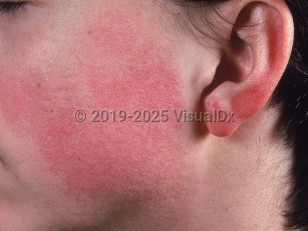Keratosis pilaris atrophicans faciei in Child
Alerts and Notices
Important News & Links
Synopsis

Keratosis pilaris atrophicans faciei (KPAF), also known as ulerythema ophryogenes, is a disorder of follicular keratinization presenting in infancy. Inheritance is thought to be autosomal dominant. Affected individuals will have hyperkeratotic papules along eyebrows and cheeks beginning in the first few months of life, which can progress into scarring alopecia. Thinning or loss of the lateral portion of the eyebrows is a common clinical finding and is often seen in conjunction with traditional keratosis pilaris involving arms and legs. Progression of the disease ceases at puberty, but sequelae are often permanent.
The condition is benign and of unknown cause. It is usually diagnosed in childhood.
KPAF has been described in patients with woolly hair, Noonan syndrome, cardiofaciocutaneous syndrome, Rubinstein-Taybi syndrome, and Cornelia de Lange syndrome. These patients will have additional features suggestive of these syndromes and may require work-up and genetic evaluation.
The condition is benign and of unknown cause. It is usually diagnosed in childhood.
KPAF has been described in patients with woolly hair, Noonan syndrome, cardiofaciocutaneous syndrome, Rubinstein-Taybi syndrome, and Cornelia de Lange syndrome. These patients will have additional features suggestive of these syndromes and may require work-up and genetic evaluation.
Codes
ICD10CM:
Q84.2 – Other congenital malformations of hair
SNOMEDCT:
400126005 – Ulerythema ophryogenes
Q84.2 – Other congenital malformations of hair
SNOMEDCT:
400126005 – Ulerythema ophryogenes
Look For
Subscription Required
Diagnostic Pearls
Subscription Required
Differential Diagnosis & Pitfalls

To perform a comparison, select diagnoses from the classic differential
Subscription Required
Best Tests
Subscription Required
Management Pearls
Subscription Required
Therapy
Subscription Required
References
Subscription Required
Last Updated:09/25/2017
Keratosis pilaris atrophicans faciei in Child

